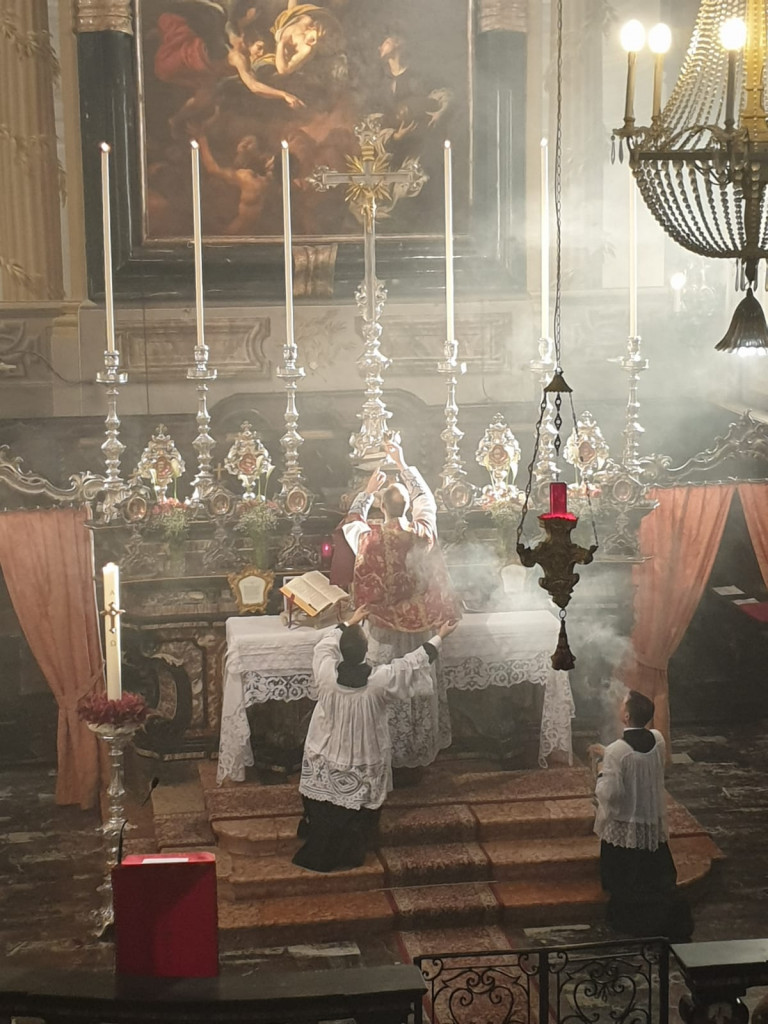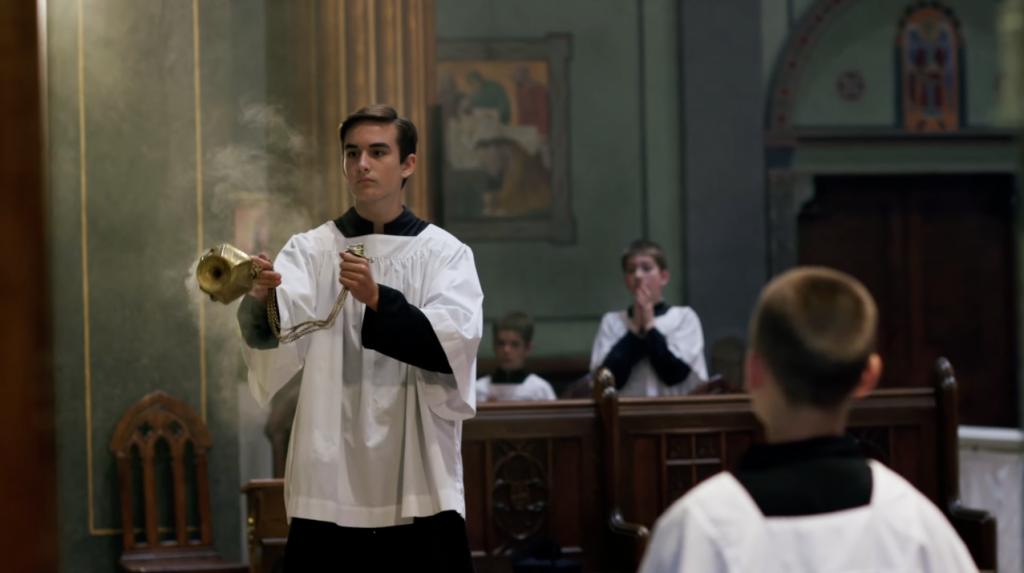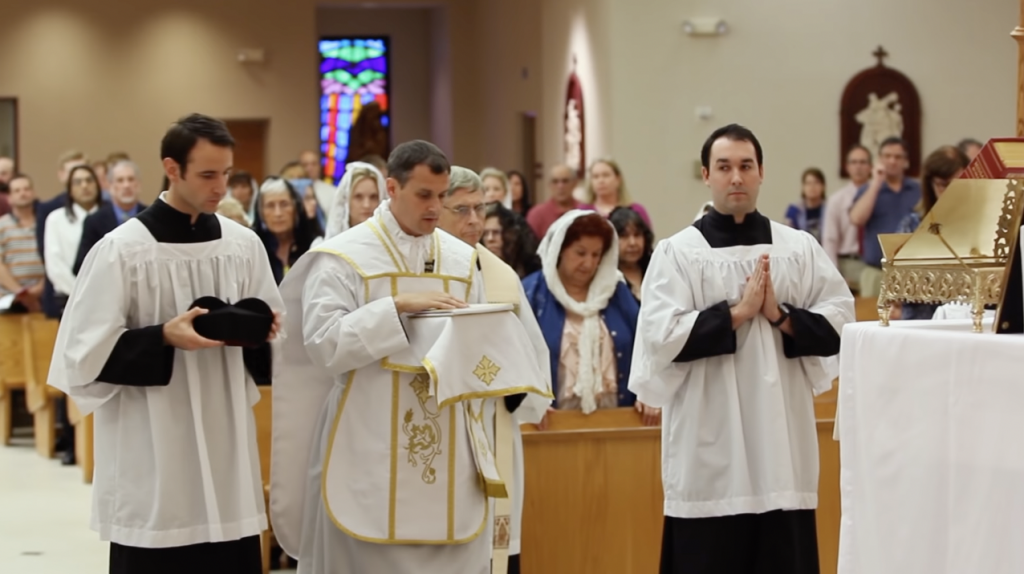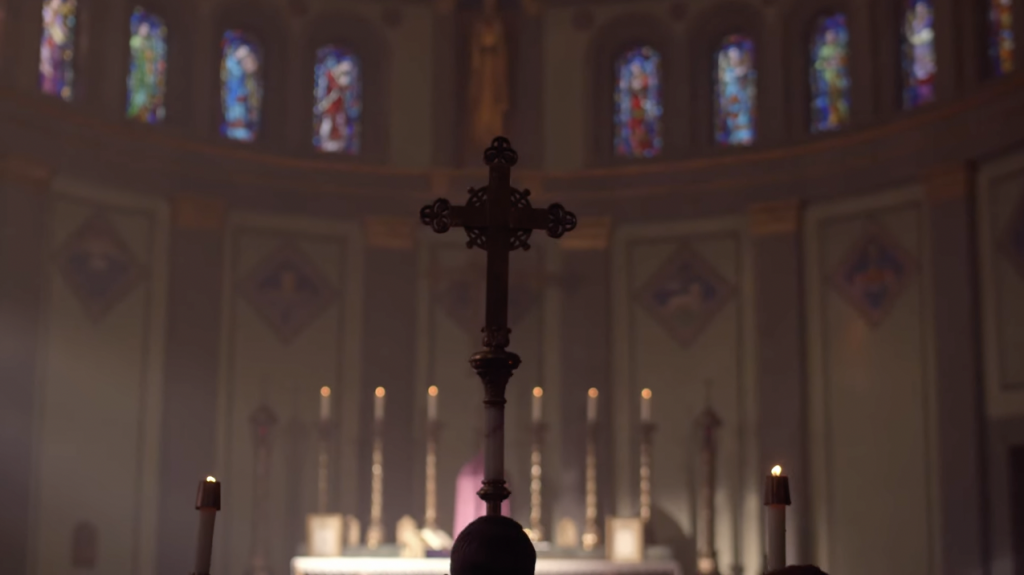versione italiana: cliccate qui
 Recent church events have aroused an unexpected curiosity in many of the faithful about the traditional liturgy, which very few are familiar with, except through hearsay or misleading stereotypes.
Recent church events have aroused an unexpected curiosity in many of the faithful about the traditional liturgy, which very few are familiar with, except through hearsay or misleading stereotypes.
After the liturgical reform of 1970, the Traditional Mass, often hastily referred to as the Latin Mass, was once again freely offered to all Catholics, without restriction, by Pope Benedict XVI, with a measure in the form of a Motu Proprio, called Summorum Pontificum, issued in July 2007*. In July 2021, a new Motu Proprio by Pope Francis imposed severe restrictions on the celebration of the Traditional Mass, which have been further tightened in recent months**.
But what is the Traditional Latin Mass (TLM)? We want to help everyone find out more, by collecting some useful information on this page, and some indications for further investigation. We hope this will make it easier to understand whether the faithful who love this ancient liturgical form, and participate in it with great devotion, really deserve the latest restrictions, so punitive, and sometimes humiliating.
Let’s start with some videos, easily available on the web, that can help us understand why the TLM is preferred by a growing number of the faithful. The texts are in English (the TLM is widely used in the USA), but you can activate subtitling in other languages:
Here you will find a recording of the full celebration of a Sunday Mass in a parish in Perth, Australia. The TLM is a tangible proof of the universality of the Church:
Finally, a little tidbit (only in English): the story of Harrison Butker, the kicker of the Kansas City Chiefs (winner of the 2023 Super Bowl thanks to one of his kickoffs; more information on MiL – Messainlatino.it), a true star of American football – the most watched sport in the USA. Butker is a Catholic whose spiritual life is marked by the traditional liturgy. In this video he talks about his faith and how important the TLM is for him and his family.
We hope that the films have shown that the traditional liturgy deserves to be truly known, without blinkers or prejudices, as do the communities that celebrate it; and that reading this page may be for all of you the first step in a growing friendship to the TLM.
In fact,«what was sacred for previous generations, remains sacred and great for us as well, and cannot be suddenly forbidden or even judged harmful. It does us all good to preserve the riches that have grown in the faith and prayer of the Church, and to give them their rightful place» (Benedict XVI).
The traditional liturgy is the liturgical rite of the Catholic Church that has been celebrated uninterruptedly from the time of Pope Gregory the Great until today, although since 1970, the traditional liturgy has been set aside and, like a heart transplant, has been replaced by a new rite, reformed and promulgated by Pope Paul VI, and, percentage-wise, there are few left who continue to celebrate in the traditional form.
The traditional Liturgy, however, like the star that guided the Magi to Bethlehem, is able to lead the whole Church back to Bethlehem, to the house of bread, that is, to the presence of the Eucharistic mystery. The traditional liturgy is able to lead the Church once again, and with renewed enthusiasm, to the presence of the divinity of the second Person of the Trinity hypostatically united to his humanity immolated bloodlessly every day, as perfect worship to his Father, on every altar in the world. The Church, on seeing this rising star, cannot feel suspicion, fear or mistrust, on the contrary she must feel, like the Magi, a «very great joy» because it leads her to see«the child with Mary his Mother», that is, to recognise that she, the Church, represented by Mary, carries nothing less than God in her arms. Imitating the Magi, the Church returns to«bow down and adore him», offering him«gold, frankincense and myrrh», thus professing its faith in the kingship, divinity and humanity, given as a sacrifice, of Jesus.
By asking the faithful to remain on their knees for a considerable part of the sacred act and by asking the priest to genuflect numerous times before coming into contact with the consecrated species, the ancient Mass shows itself for what it really is: a great kerygma/announcement. The word kerygma is derived from the Greek, which literally means«to shout». The ancient Mass shouts/announces that the most appropriate attitude with which man recognises the Mystery of God is adoration, that is, as the very etymology of the word evokes, an act of loving submission, of reverent obedience, of affectionate acceptance of His majesty. Man recognises and feels himself to be a creature whose origin and destination start from and are oriented towards the Creator. If one rejects this vision, there can only be an illusory and arrogant anthropocentrism, the one that has produced so many wounds and so much pain, especially in the last two centuries, by removing hope from the hearts of men, as Pope Benedict XVI masterfully demonstrated in his encyclical Spe salvi.
Very frequent are the genuflections of the priest during the traditional Mass. Each genuflection before the Blessed Sacrament represents an act of faith in Christ. Kneeling, the principal gesture of adoration, is not an act of humiliation, but only of humility.
There are many other examples: kissing the altar, beating one’s chest are frequent actions in the 1962 Missal as in Eastern liturgies. The Rite nourishes prayer and faith. For example, the ceremonies that accompany the consecration help one to believe in the reality of the sacrifice of the Mass: when in the midst of the silent canon, a bell tolls, the bell rings in the church shrouded in silence, the thurible releases its perfumed clouds, the ad faces surround the altar with their candles and the entire assembly is kneeling, the visitor, who has entered the church by chance, immediately understands that something is happening that goes far beyond appearances. We know that the Lord prayed on his knees, that Stephen, Peter and Paul prayed on their knees. By bending the knees in the name of Jesus, the Church proclaims the Truth. In the same way, it is a beautiful manifestation of faith to see, at the moment of communion, the whole assembly kneel and beat their chests at the threefold Domine non sum dignus, to see the priest carrying the Blessed Sacrament advancing towards the balustrades, an extension of the altar, preceded by those who carry the candles, and each member of the faithful, humbly kneeling, receiving the body of Christ from the consecrated hands of the priest. The signs of adoration and veneration towards the Blessed Sacrament facilitate the faith of young people who have to live in a society where Christianity tends to disappear, and their generous presence at the Ancient Rite confirms that this symbolic language speaks to their inner universe.
Every man’s heart is made for the Lord. The alternative is nothingness. Perhaps one should really ask oneself whether the heart transplant that has been made with the liturgical reform, whether the abandonment of this latreutic and adoring dimension in the liturgy in favour of a “more joyful rhythm”, almost festive, verbally didactic, has not contributed to the collapse of faith and pushed men and young people to look elsewhere, unsuccessfully, for the source capable of quenching their inner thirst. The ancient Mass, with this attitude of humble adoration, instils in believers a sense of the fear of God. On his knees, man learns to obey God and his precepts. Morality, in fact, is as much a part of the catechism as the Creed.
«I am convinced that the ecclesial crisis in which we find ourselves today depends largely on the collapse of the liturgy». Benedict XVI, with a prophetic gaze, went to the heart of the problem of the Church today: there is a profound crisis of faith taking place and this crisis is caused by the collapse of the liturgy.
The Holy Father Benedict XVI, with courageous lucidity, has therefore made a diagnosis of the situation of the Church with all the harmful consequences that have resulted in recent years. With the same courageous lucidity, full, in fact, of parrhesia, he also indicated the way out: start again from the liturgy, because it is urgent to start again from the Centre, from the Heart, in a word, from Christ: «We must rediscover the courage of the Sacred».
Learn even more! Essential bibliography (Italian and international).
Joseph Ratzinger, Introduzione allo spirito della liturgia, San Paolo Edizioni, 2001
Uwe Michael Lange, Rivolti al Signore. L’orientamento nella preghiera liturgica, Edizioni Cantagalli, 2008
Uwe Michael Lange, La voce della Chiesa in preghiera, Edizioni Cantagalli, 2016
Claude Barthe, Storia del messale tridentino, Solfanelli, 2018
Claude Barthe, Una foresta di simboli: Il senso mistico-allegorico della Messa tradizionale, Fede & Cultura, 2019
Peter Kwasniewski, Nobile bellezza, sublime santità. Perché la modernità ha bisogno della messa tradizionale, Fede & Cultura, 2021
Meum ac vestrum sacrificium: Introduzione alla Messa Tridentina, Chorabooks, 2021
Peter Kwasniewski, The Once and Future Roman Rite: Returning to the Traditional Latin Liturgy after Seventy Years of Exile, TAN Books, 2022
Uwe Michael Lange, The Roman Mass: From Early Christian Origins to Tridentine Reform, Cambridge University Press, 2022
La Messa cattolica: Passi per ripristinare la centralità di Dio nella liturgia, Chorabooks, 2022
Joseph Shaw, The Liturgy, the Family, and the Crisis of Modernity: Essays of a Traditional Catholic, Sophia Institute Press, 2022
Roberto Spataro SDB, La Messa del futuro, Fede & Cultura, 2022
Claude Barthe, Quel avenir pour la Messe traditionnelle?, Contretemps Ed., 2023.
____________________________________________
* Motu Proprio Summorum Pontificum, latin version; Motu Proprio Summorum Pontificum, english version; Letter of His Holiness Benedict XVI to the Bishops on the occasion of the publication of the Apostolic Letter “Motu Proprio Data” Summorum Pontificum on the use of the roman liturgy prior to the reform of 1970.
** Motu Proprio Traditionis Custodes, latin version; Motu Proprio Traditionis Custodes, english version; Letter of the Holy Father Francis to the Bishops around the world to present the Motu Proprio “Traditionis Custodes” on the use of the Roman Liturgy prior to the 1970 Reformation, 16.07.2021; Rescriptum ex audientia SS.mi, 21.02.2023; Responsa ad dubia of the Congregation for Divine Worship and the Discipline of the Sacraments on certain provisions of the Apostolic Letter TRADITIONIS CUSTODES issued “Motu Proprio” by the Supreme Pontiff Francis, 18.12.2021.





